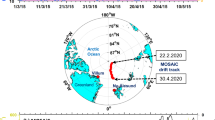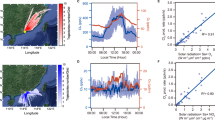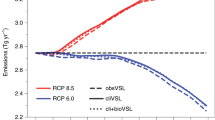Abstract
The fate of many atmospheric trace species, including pollutants such as nitrogen oxides and some volatile organic compounds, is controlled by oxidation reactions. In the daytime troposphere, these reactions are dominated by photochemically produced OH radicals; at night and in polluted environments, NO3 radicals are an important oxidant1. Ozone can contribute to the oxidation of atmospheric species during both day and night1. In recent years, laboratory investigations2,3,4, modelling studies5,6,7, measured Cl deficits in marine aerosols8 and species-nonspecific observations9,10,11 of gaseous inorganic chlorine compounds other than HCl have suggested that reactive halogen species may contribute significantly to—or even locally dominate—the oxidative capacity of the lower marine troposphere. Here we report night-time observations of molecular chlorine concentrations at a North American coastal site during onshore wind flow conditions that cannot be explained using known chlorine chemistry. The measured Cl2 mixing ratios range from <10 to 150 parts per 1012 (p.p.t.), exceeding those predicted5 for marine air by more than an order of magnitude. Using the observed chlorine concentrations and a simple photochemical box model, we estimate that a hitherto unrecognized chlorine source must exist that produces up to 330 p.p.t. Cl2 per day. The model also indicates that early-morning photolysis of molecular chlorine can yield sufficiently high concentrations of chlorine atoms to render the oxidation of common gaseous compounds by this species 100 times faster than the analogous oxidation reactions involving the OH radical, thus emphasizing the locally significant effect of chlorine atoms on the concentrations and lifetimes of atmospheric trace species in both the remote marine boundary layer and coastal urban areas.
This is a preview of subscription content, access via your institution
Access options
Subscribe to this journal
Receive 51 print issues and online access
$199.00 per year
only $3.90 per issue
Buy this article
- Purchase on Springer Link
- Instant access to full article PDF
Prices may be subject to local taxes which are calculated during checkout



Similar content being viewed by others
References
Finlayson–Pitts, B. J. & Pitts, J. N. J Atmospheric Chemistry: Fundamentals and Experimental Techniques (Wiley, New York, 1986).
Finlayson-Pitts, B. J. Chlorine atoms as a potential tropospheric oxidant in the marine boundary layer. J. Res. Chem. Intermed. 19, 235–249 (1993).
Keene, W. C. in Naturally-Produced Organohalogens (eds Grimvall, A. & de Leer, E. W. B.) 363–373 (Kluwer Academic, Norwell, MA, 1995).
Behnke, W., Scheer, V. & Zetzsch, C. in Naturally-Produced Organohalogens (eds Grimvall, A. & de Leer, E. W. B.) 375–384 (Kluwer Academic, Norwell, MA, 1995).
Vogt, R., Crutzen, P. J. & Sander, R. Amechanism for halogen release from sea-salt aerosol in the remote marine boundary layer. Nature 383, 327–330 (1996).
Sander, R. & Crutzen, P. J. Model study indicating halogen activation and ozone destruction in polluted air masses transported to the sea. J. Geophys. Res. 101, 9121–9138 (1996).
Singh, H. B. & Kasting, J. F. Chlorine-hydrocarbon photochemistry in the marine troposphere and lower stratosphere. J. Atmos. Chem. 7, 261–285 (1988).
Keene, W. C. et al. The geochemical cycling of reactive chlorine through the marine troposphere. Glob. Biogeochem. Cycles 4, 407–430 (1990).
Pszenny, A. A. P. et al. Evidence of inorganic chlorine gases other than hydrogen chloride in marine surface air. Geophys. Res. Lett. 20, 699–702 (1993).
Impey, G. A., Shepson, P. B., Hastie, D. R., Barrie, L. A. & Anlauf, K. Measurements of photolyzable chlorine and bromine during the Polar Sunrise Experiment 1995. J. Geophys. Res. 102, 16005–16010 (1997).
Maben, J. R., Keene, W. C., Pszenny, A. A. P. & Galloway, J. N. Volatile inorganic Cl in surface air over eastern North America. Geophys. Res. Lett. 22, 3513–3516 (1995).
Spicer, C. W., Kenny, D. V., Shaw, W. J., Busness, K. M. & Chapman, E. G. Alaboratory in the sky: New frontiers in measurements aloft. Environ. Sci. Technol. 28, 412A–420A (1994).
Chapman, E. G., Kenny, D. V., Busness, K. M., Thorp, J. M. & Spicer, C. W. Continuous airborne measurements of gaseous formic and acetic acids over the western North Atlantic. Geophys. Res. Lett. 22, 405–408 (1995).
Spicer, C. W., Kenny, D. V., Chapman, E. G., Busness, K. M. & Berkowitz, C. M. Observations of dimethyl sulfide over the western North Atlantic Ocean using an airborne tandem mass spectrometer. J. Geophys. Res. 101, 29137–29147 (1996).
Fast, J. D. & Berkowitz, C. M. Amodeling study of boundary-layer processes associated with ozone layers observed during the 1993 North Atlantic Regional Experiment. J. Geophys. Res. 101, 28683–28699 (1996).
Lurmann, F. W., Lloyd, A. C. & Atkinson, R. Achemical mechanism for use in long-range transport/acid deposition computer modeling. J. Geophys. Res. 91, 10905–10936 (1986).
Yin, F., Grosjean, D. & Seinfeld, J. H. Photooxidation of dimethyl sulfide and dimethyl disulfide. I: Mechanism development. J. Atmos. Chem. 11, 309–364 (1990).
Zaveri, R. A. Development and Evaluation of A Comprehensive Tropospheric Chemistry Model for Regional and Global Applications. Thesis, Virginia Polytechnic Inst. (1997).
Gery, M. W., Whitten, G. Z., Killus, J. P. & Dodge, M. C. Aphotochemical kinetics mechanism for urban and regional scale computer modeling. J. Geophys. Res. 94, 12925–12956 (1989).
Ragains, M. L. & Finlayson-Pitts, B. J. Kinetics and mechanism of the reaction of Cl atoms with 2-methyl-1,3-butadiene (isoprene) at 298K. J. Phys. Chem. 101, 1509–1517 (1997).
1. Bonsang, B., Polle, C. & Lambert, G. Evidence for marine production of isoprene. Geophys. Res. Lett. 19, 1129–1132 (1992).
DeMore, W. B. et al. Chemical Kinetics and Photochemical Data for Use in Stratospheric Modeling (Rep. 97-4, Jet Propulsion Lab., Pasadena, CA, 1997).
Atkinson, R. Gas phase tropospheric chemistry of volatile organic compounds: 1. Alkanes and alkenes. J. Phys. Chem. Ref. Data 26, 215–290 (1997).
Oum, K. W., Lakin, M. J., DeHaan, D. O., Brauers, T. & Finlayson-Pitts, B. J. Formation of molecular chlorine from photolysis of ozone and aqueous sea salt particles. Science 279, 74–77 (1998).
Chameides, W. L. & Stelson, A. W. Aqueous-phase chemical processes in deliquescent sea-salt aerosols: A mechanism that couples the atmospheric cycles of S and sea salt. J. Geophys. Res. 97, 20565–20580 (1992).
Keene, W. C. et al. Comment on “Aqueous-phase chemical processes in deliquescent sea-salt aerosols: A mechanism that couples the atmospheric cycles of S and sea salt” by W. L. Chameides and A. W. Stelson. J. Geophys. Res. 98, 9047–9049 (1993).
Acknowledgements
We thank pilots R. V. Hannigan and M. J. Warren for their invaluable help during the field studies; X. Bian for graphics preparation; and W. C. Keene, R. D. Saylor, J. A. Shorter and W. R. Barchet for discussions. We acknowledge the financial support of the US Department of Energy's Atmospheric Chemistry Program.
Author information
Authors and Affiliations
Corresponding author
Rights and permissions
About this article
Cite this article
Spicer, C., Chapman, E., Finlayson-Pitts, B. et al. Unexpectedly high concentrations of molecular chlorine in coastal air. Nature 394, 353–356 (1998). https://doi.org/10.1038/28584
Received:
Accepted:
Issue Date:
DOI: https://doi.org/10.1038/28584
This article is cited by
-
Laser induced fluorescence and computational studies on the tropospheric photooxidation reactions of methyl secondary butyl ether initiated by OH radicals
Environmental Science and Pollution Research (2023)
-
Fate of 1,3-dioxolane in the troposphere: kinetics, mechanism with theoretical support, and atmospheric implications
Journal of Atmospheric Chemistry (2023)
-
Photodissociation of particulate nitrate as a source of daytime tropospheric Cl2
Nature Communications (2022)
-
Oxidative degradation of phenols and substituted phenols in the water and atmosphere: a review
Advanced Composites and Hybrid Materials (2022)
-
Kinetics for the photo-chemical degradation of Methyl butyrate in presence of Cl atoms and OH radicals
Journal of Atmospheric Chemistry (2021)
Comments
By submitting a comment you agree to abide by our Terms and Community Guidelines. If you find something abusive or that does not comply with our terms or guidelines please flag it as inappropriate.



